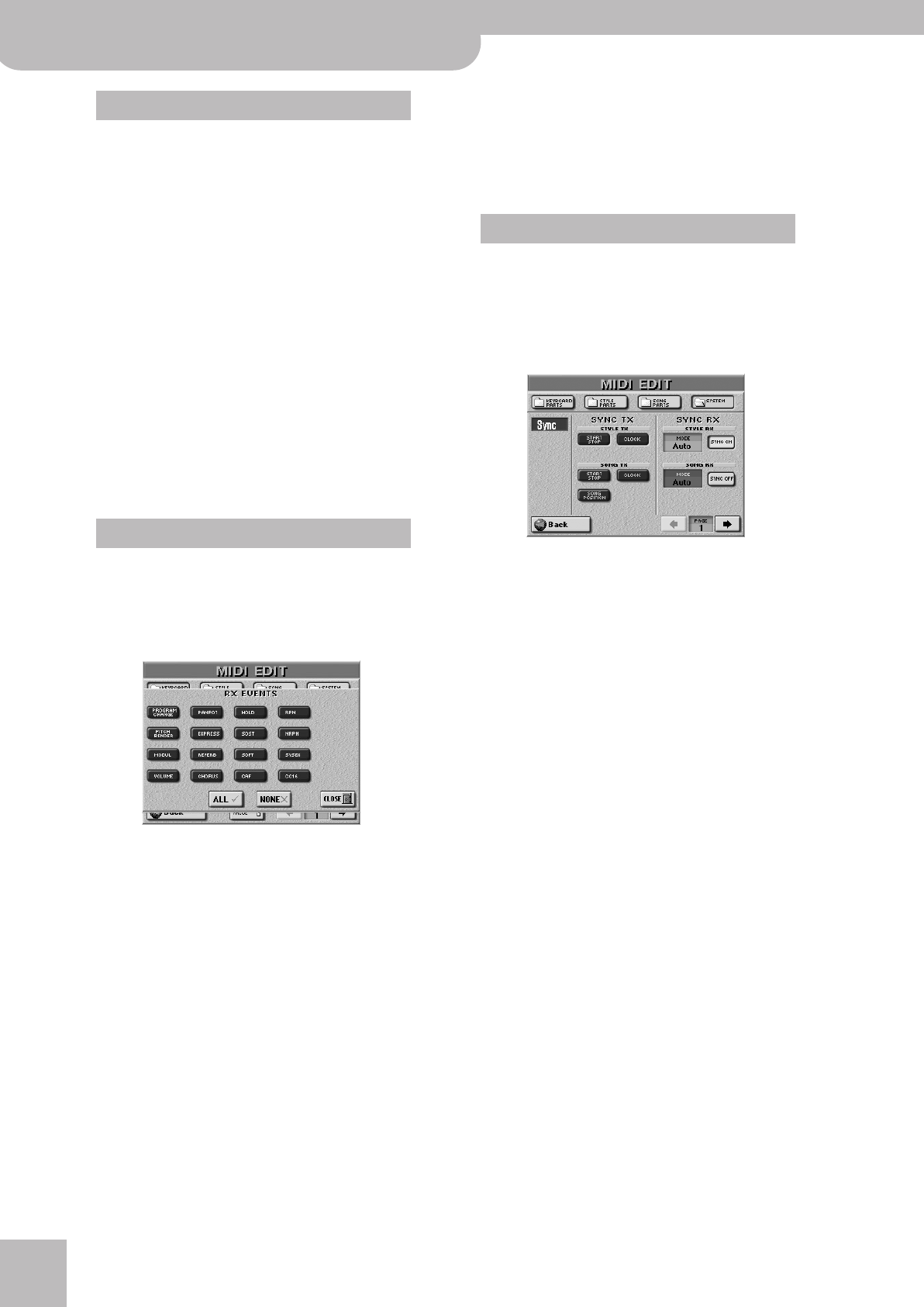
MIDI
190
r
E-60/E-50 Music Workstation
■CHANNEL (1~16)
Allows you to assign a MIDI receive channel to the selected
part. The default settings usually work best, but you are
most welcome to change them.
Note: Unless you have a very good reason to do otherwise, we
suggest using the same TX and RX channel numbers for a part.
Note: Assigning the same channel to two or more parts is usu-
ally not a very good idea.
■SHIFT (–48~48)
This parameter allows you to transpose the received note
messages before sending them to the E-60/E-50’s tone
generator. The maximum possible transposition is four
octaves up (48) or down (–48). Each step represents a semi-
tone.
■LIMIT HIGH/LIMIT LOW (C–~G9)
“LIMIT HIGH” and “LIMIT LOW” allow you to set the note
range to be received. If not all note messages received on a
given MIDI channel should be played by the selected E-60/
E-50 part, narrow down the range.
Note: The LOW LIMIT value cannot be higher value than HIGH
LIMIT (and vice versa).
The data filters of the RX section allow you to specify
whether (ON) or not (OFF) the messages in question
should be received.
Press the [RX¥EVENT] field to open the following
pop-up window:
The RX events are the same as the TX events, except
for the “CAF” parameter (reception of Channel After-
touch messages), which can be received – or filtered.
Press the [Back] field and save your settings to a
MIDI Set; —or—
Press the [EXIT] button to return to the main page.
MIDI System parameters
The following MIDI parameters usually apply to the
E-60/E-50 as a whole, even though some of them are
rather specific, as you will notice.
Press the [SYSTEM] field and use PAGE [ø][˚] to select
the page that contains the parameter you want to edit.
The SYNC parameters allow you to specify whether or
not the E-60/E-50 should send MIDI real-time mes-
sages when you start the Arranger or Recorder/
sequencer. This allows you to synchronize external
instruments or (software) sequencers with your E-60/
E-50.
Just as a reminder: “TX” means “transmit” and “RX”
stands for “receive”.
■SYNC TX
● START/STOP—If you activate this option, the E-60/E-50
sends start or stop messages when you start (or stop)
Arranger (STYLE) or song (SONG) playback. (The
Recorder/sequencer furthermore transmits “Continue”
messages.)
● CLOCK—This option means that the Arranger (STYLE) or
Recorder/sequencer (SONG) sends MIDI Clock messages
that tell the receiving instrument or MIDI device which
tempo to choose.
● SONG POSITION (only for SONG)—If you switch this
parameter on, the Recorder/sequencer sends Song Posi-
tion Pointer (SPP) messages that indicate the current
playback position.
Note: See your external sequencer’s, etc., manual to find
out whether it accepts Song Position Pointer messages.
■SYNC RX
The SYNC RX parameters allow you to specify
whether and how the Arranger (STYLE) and/or
Recorder/sequencer (SONG) should be synchronized
to external sequencers, drum machines, etc. The
available options are:
● Auto—This is a good setting for remote control of song
or Style playback (using a PK-5A dynamic MIDI pedal
board, for example). If the E-60/E-50 receives a MIDI
Start message (FA), it waits for Clock messages that
specify the tempo. If those Clock messages are not
received (a PK-5A, for instance, doesn’t send them), the
E-60/E-50 starts playback using its internal tempo. If,
however, Clock messages (F8) follow after the Start mes-
sage, the E-60/E-50 uses the external tempo. You can
nevertheless go on using the Recorder/sequencer or
Arranger without MIDI Start/Clock messages, which is
not possible when you select “MIDI”.
MIDI RX
RX EVENT
SYNC parameters
E-60_50_OM_UK.book Page 190 Thursday, June 22, 2006 10:06 AM


















